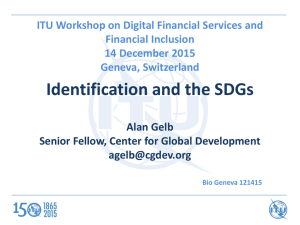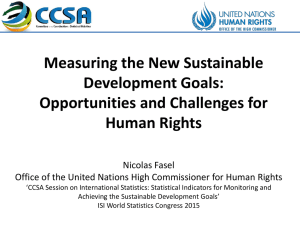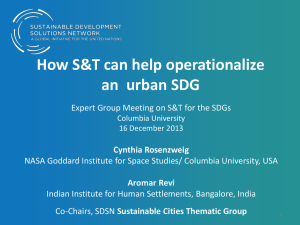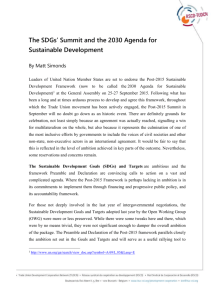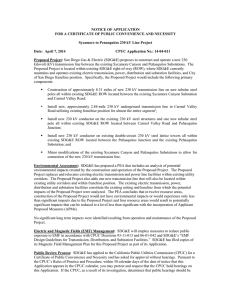Population Matters
advertisement
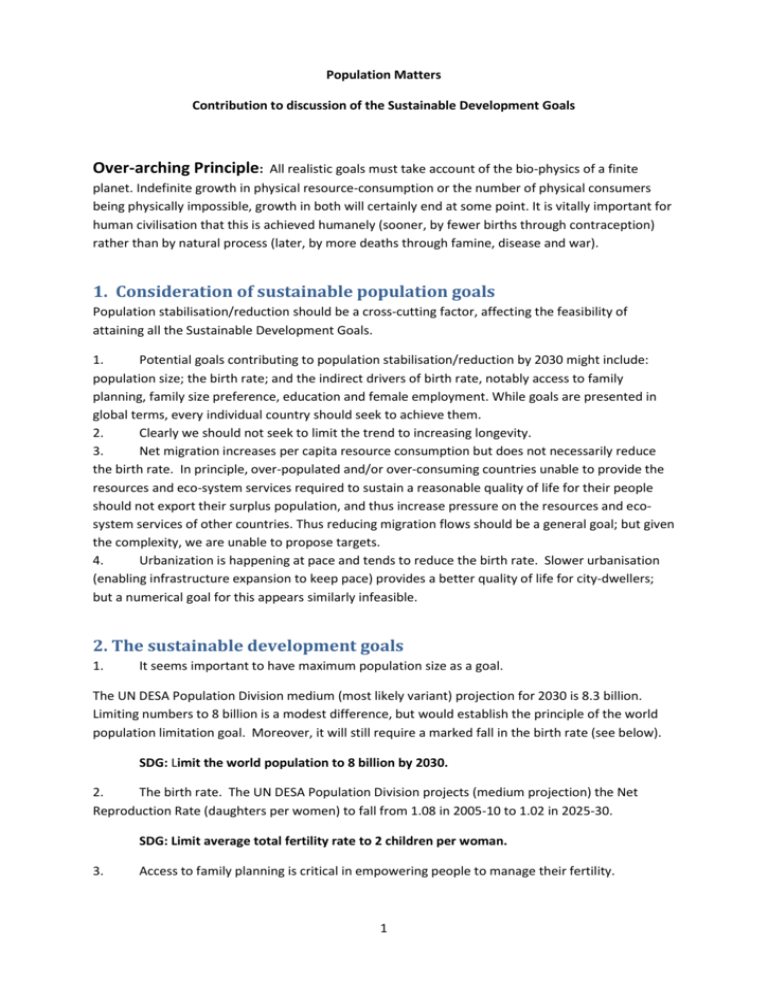
Population Matters Contribution to discussion of the Sustainable Development Goals Over-arching Principle: All realistic goals must take account of the bio-physics of a finite planet. Indefinite growth in physical resource-consumption or the number of physical consumers being physically impossible, growth in both will certainly end at some point. It is vitally important for human civilisation that this is achieved humanely (sooner, by fewer births through contraception) rather than by natural process (later, by more deaths through famine, disease and war). 1. Consideration of sustainable population goals Population stabilisation/reduction should be a cross-cutting factor, affecting the feasibility of attaining all the Sustainable Development Goals. 1. Potential goals contributing to population stabilisation/reduction by 2030 might include: population size; the birth rate; and the indirect drivers of birth rate, notably access to family planning, family size preference, education and female employment. While goals are presented in global terms, every individual country should seek to achieve them. 2. Clearly we should not seek to limit the trend to increasing longevity. 3. Net migration increases per capita resource consumption but does not necessarily reduce the birth rate. In principle, over-populated and/or over-consuming countries unable to provide the resources and eco-system services required to sustain a reasonable quality of life for their people should not export their surplus population, and thus increase pressure on the resources and ecosystem services of other countries. Thus reducing migration flows should be a general goal; but given the complexity, we are unable to propose targets. 4. Urbanization is happening at pace and tends to reduce the birth rate. Slower urbanisation (enabling infrastructure expansion to keep pace) provides a better quality of life for city-dwellers; but a numerical goal for this appears similarly infeasible. 2. The sustainable development goals 1. It seems important to have maximum population size as a goal. The UN DESA Population Division medium (most likely variant) projection for 2030 is 8.3 billion. Limiting numbers to 8 billion is a modest difference, but would establish the principle of the world population limitation goal. Moreover, it will still require a marked fall in the birth rate (see below). SDG: Limit the world population to 8 billion by 2030. 2. The birth rate. The UN DESA Population Division projects (medium projection) the Net Reproduction Rate (daughters per women) to fall from 1.08 in 2005-10 to 1.02 in 2025-30. SDG: Limit average total fertility rate to 2 children per woman. 3. Access to family planning is critical in empowering people to manage their fertility. 1 SDG: Universal access to a full range of affordable family planning commodities and services. 4. Employment of women motivates couples to limit their family size. SDG: Ensure gender parity in employment rates. 5. We support contraction and convergence between the rich and poor, as this would tend to reduce the birth rate. Under the MDGs, the proportion of people living in extreme poverty i.e. under $1.25 per day fell by half from 1990 to 2010. However, a smaller proportion of a larger number can still be a larger number, as has happened in Africa; and it is numbers of people, not rates or proportions, that need ever-increasing food, water, soil, energy etc. SDG: Reduce the number of people in extreme poverty by half. 6. Increasing workforce participation would serve to reduce the demand for additional births and is inherently more sustainable. Currently, 200 million people are unemployed (ITUC). SDG: Reduce the number of unemployed and under-employed by half. 7. Secondary education for women increases female workforce participation. Gender parity of participation in primary education was achieved by the MDGs. SDG: Achieve gender parity in secondary education. 8. Child marriage undermines women’s employment options, and increases birth rates. SDG: End marriage under the age of eighteen. 9. We should not subsidize larger families in general in order to lower the birth rate. SDG: End payments or other benefits related to the number of children except for reasons of health, education and targeted poverty alleviation. 10. A reduction in the desired family size is essential to reduce the birth rate. Social marketing should be used to encourage smaller families. SDG: Achieve a majority preference for a family size of two or fewer. 11. Sex education is important in birth rate reduction, though hard to measure. SDG: Provide universal sex and relationships education, including family planning. 12. Safe abortion is an essential contingency preventing unwanted pregnancy where contraception fails. With good family planning services and education, abortion should be legal, safe, and increasingly rare. SDG: Provide access to legal and safe abortion on demand. 2


![GRP-1[1]](http://s2.studylib.net/store/data/027198969_1-8f9a7f6ce26a57b69a934194b75ff0bd-300x300.png)

